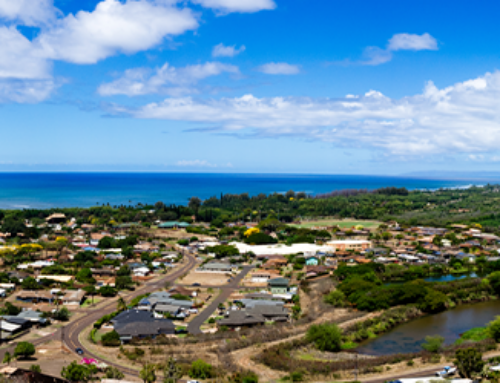There are two kinds of people in this world: Those who hire movers and those who are determined to do it themselves. If you fall in the latter category, more power to you! You might not know this, but Royal Hawaiian is rooted in a moving business that started with two men and a truck. In other words, the “can do” attitude is in our DNA, so we’d love to help you make your DIY move a safer and easier one.
In that spirit, we talked with Frank Valenti, our Safety and Technical Training Director, to get his tips on how you can protect your body (and your belongings!) during your DIY move.
Tip #1: Communication Is Key
In training our teams at Royal Hawaiian, communication is one of the first things that Frank works on with our trainees. Specifically, he tells them that if you see something that doesn’t look right or seems potentially dangerous, don’t be afraid to speak up.
The same goes for you: Communicate early and often, especially if something doesn’t sit right with you. For example, maybe the ramp you’re using seems unstable. It would be better for you to say something before someone else tumbles off it while carrying a full load.
Now, if you’re one of the younger members of the group, you might be reluctant to speak up, especially if someone who’s older or more experienced is running the show. However, a small correction—such as moving the truck forward so you can stabilize the ramp on even ground—can prevent an accident or injury before it happens.
Finally, if you are the senior, experienced person leading the move, make sure you encourage your fellow helpers to speak up by giving thought to their observations and feedback.
All of this will ensure that you…
Tip #2: Think Like a Team
As Frank told us, “What we think of as common sense isn’t common. Common sense is based on a common set of beliefs, skills, and experiences. So if you’ve been moving furniture for 20 years, your set of beliefs, skills, and experiences will be very different than someone who’s never done it before.”
This is important to remember in DIY moves, which can often bring together a diverse set of people. For example, maybe you’ve got a father, a son, and a daughter all working together, with a few cousins mixed in. Everyone will have a different set of beliefs, skills, and experiences—and therefore, a different kind of “common sense.”
Knowing this, if you want to really work well together as a team, it comes back to tip #1: communication. Talk through your thought process and explain why you want to load the bed first, then the couch, then the bookcase. By explaining your reasoning, you may not quite achieve the same level of common sense—but you can at least get on common ground. And when everyone’s on the same page, you’re more likely to look out for each other and work well together, like a true team.
And if there’s one thing everyone on the team should agree on, it’s this…
Tip #3: Protect Your Body
Where do the biggest challenges occur in a move? You might imagine ropes snapping, dollies overturning or towers of boxes collapsing. However, Frank told us that it’s rarely that catastrophic—or dramatic. Instead, the biggest problems he sees during moves involve sprains and strains, soft tissue injuries that can leave you hurting the next day (and beyond!).
So what’s the best way to prevent them?
- Our crews warm-up and stretch before they start the heavy lifting, in order to prepare their bodies for the work they’re about to do. We suggest you do the same!
- Ask for help with pieces that are too heavy or awkward to pick up and carry. There’s no shame in asking for a team lift, and your body will thank you at the end of the day.
When it comes to avoiding problems, it’s also important that you…
Tip #4: Know Where the Pressure Points Are
Frank also shared with us that injuries and accidents happen most frequently in two scenarios:
- When people are in a rush. If the clock is ticking and you need to be out of your home pronto, it’s easy to take on too much at once. It’s also easy to get caught up in the adrenaline of the moment and power lift that solid-wood coffee table. That’s when injuries happen. Make sure you plan plenty of time for your move so you can work slowly and carefully.
- With people who are less experienced. The majority of on-the-job moving injuries happen with people who have less than a year on the job. Unless you’re moonlighting as a professional mover, that means you. Your best bet? Know your limits. Don’t take on too much, and know when to get some help, which leads us to our final tip…
Tip #5: If You Do Hire Movers, Look for Experts
Some people start packing for their move, then realize they either don’t have the time or the desire to do the move entirely by themselves. There’s no shame in calling in reinforcements!
If you find yourself in this scenario—and you’re looking to get some kind of assistance with your move—Frank’s recommendation is to look for movers who have expertise around your unique moving situation. In his words, “You don’t want them to figure it out on your move.”
Moving from Hawaii to the mainland (or vice versa!) is a great example. Packing a truck to move your possessions ~25 miles from start to finish is a whole different animal than packing a container that’s going to travel over the road, then thousands of miles across the Pacific Ocean to Hawaii.
Whether you’re moving to the Aloha State, transporting a specialty item like a piano, or relocating a valuable collection of fine art, make sure that the professionals you choose have experience in that particular area. You’ll rest a lot easier knowing you’ve hired a crew with the experience they need to get your belongings to your new house safely.
DIY Moves, Done Right
Moving all of your personal possessions is something that can feel, well, personal. So if you want to handle your move on your own, we get it! As Frank likes to remind our Royal Hawaiian trainees, it’s not just 6,000 pounds of household goods they’re driving around. It’s someone’s whole life, and it deserves to be treated carefully.
If you’re the DIY type, we hope the tips in this article keep you, your family, and your possessions safe as you make your next move.
And if you decide you’re not a die-hard DIY-er—and you’d like some help—we’re always here for you. Just reach out to us for a free quote to get started.



